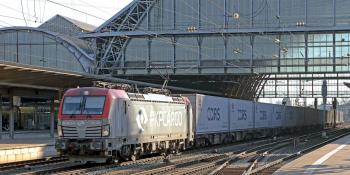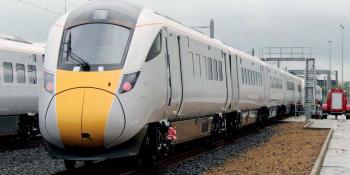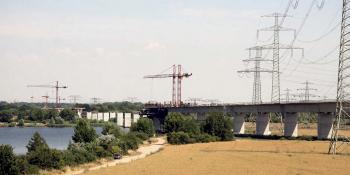

EUROPE

LEO EXPRESS EXPANDS CROSS-BORDER SERVICES
Czech open access operator Leo Express became the first non-Polish operator to offer inter-city services in Poland on 20 July when it launched services from Prague to Krakow. Operating twice a week (leaving Prague on Friday and Sunday, returning south on Saturday and Monday), they use the already intensively diagrammed Leo Express fleet of five Stadler Flirt EMUs, with calls at major Czech stations between Prague and Bohumin plus several in Poland.
Leo Express offers fares for the Prague to Krakow journey priced between €4.50 and €62 in its business class section. These fares are all available online in multiple languages, the ease of purchase being one of the attractions for many prospective passengers, especially those who would rather book on their smartphone than queue up at a station. Incumbents Czech Railways (ČD) and Polish national operator PKP Intercity operate one direct Eurocity train on the route (and several more with a change of trains in Katowice), with ČD (but not PKP IC) offering internet advance fares from around €19. ‘Walk up’ fares are €78 (second class) or €116 (first class), and unlike Leo Express these tickets can be bought only at major stations or from travel agents. Journey times vary little between operators.
Major engineering work is being undertaken in the greater Krakow area, with the main east – west line through the city and over the river Vistula reduced to single track for most of this year and continuing into next year. As a result, the new services have been given circuitous paths in Silesia, leading to Leo Express replacing trains with long-distance buses for most of October and November (the company already operated international buses serving Poland). When announcing this bus replacement operation, the company was very keen to point out its trains have operated largely full and that the suspension of rail services was ‘a temporary measure’ due to unacceptable timings.
Leo Express has three new EMUs on order from Chinese manufacturer CRRC due for delivery in late 2018. It has plans to expand its services between the Czech Republic and Poland and is planning to launch a service connecting Prague and Wrocław in south western Poland, in conjunction with regional operator Koleje Dolnośląskie. It has previously announced plans to introduce trains between Prague and Berlin in December 2018, although no further details of this planned service have been disclosed.
PASSENGER DATA EXCHANGE TRIAL
The Belgian government has approved a trial of passenger data exchange for ground cross-border passenger transport; similar rules already apply to anyone flying in or out of Belgian and other EU airports. The trial exchange of Passenger Name Record (PNR) data has also been agreed with the UK government and will be tested on Eurostar services between Brussels and London. Long-distance bus operator Flixbus is also included for its services operating from Belgium.
According to reports in the Belgian media the information will be given to the Passenger Information Unit, a new unit within the Interior Ministry. Known as the Federal Public Service of Belgium, the unit is where Belgian Federal Police, customs, security services and military intelligence share data. In justifying the move the Belgian government highlights the European PNR Directive, which requires airlines to transmit passenger data to government member states and allows states to determine their own approach for trains, buses and ferries.
The Belgian government sees the trials as pilots to be undertaken before deploying the system more widely; whether this will include all intra-Schengen rail travel is unclear – and currently impractical as apart from Eurostar and Thalys no operator requires identification information or pre-reservation. It is hard to see how such a system could be applied to the many cross-border services operating from Belgium to the Netherlands and Germany daily without many more staff and considerable bureaucracy – and unless the measure is to be entirely discriminatory towards rail transport it will need to be applied to the road network. Without instituting similar requirements on the hundreds of thousands of motorists who cross Belgium’s borders daily, the entire exercise will be pointless as those wishing to avoid being detected will find a car to travel in!
AUSTRIA

SUMMER STEAM RACK RAILWAY TO OPERATE YEAR-ROUND?
The Achenseebahn is a steam-operated 6.7km-long metre-gauge Riggenbach rack-equipped line from Jenbach to the Achensee lake, over 400 metres above the town. It currently operates only in summer as both snow and operating costs prevent any prospect of winter operation. The railway, owned since 1991 primarily by the local governments in the area it serves, receives no state or regional funding for infrastructure repairs or investment; as it is not a year-round operation it is not considered part of the public transport system eligible for such funding.
The railway has evaluated how it could operate year-round and thus gain from public transport funding. Whilst electrification is attractive for some reasons it is also expensive, and catenary might ‘spoil’ the summer steam operation, so unusually diesel traction is the preferred option for off-season trains. The operator has bought five rack-fitted EMUs secondhand from the Appenzeller Bahn in Switzerland and intends to convert them to DEMUs, assuming funding can be found to do this.
GERMANY

FLIXTRAIN EXPANDS
Flixtrain, the rail subsidiary of European market-leading long-distance bus operator Flixbus took over marketing of the former HKX branded trains on the Köln to Hamburg route on 23 March. On 19 July it expanded the service frequency to two train pairs a day, thus offering 20 trains per week on the route. Services do not operate every day of the week, especially on Tuesdays and Wednesdays. Most services make the journey between Köln and Hamburg Hbf in between 4hr 5min and 4hr 10min, which is comparable with most Deutsche Bahn long-distance services (although these take a longer route also serving Bremen). Flixtrain services on the route are operated by Nuremberg-based Bahn Touristik Express, which is 50% owned by American rail investor and HKX founder Railroad Development Corporation.

In June Flixtrain also doubled service frequency on the Berlin to Stuttgart route it has operated in conjunction with Czech operator Leo Express since August 2017. Trains on the Berlin to Stuttgart route are operated by Hector Rail using a mixture of coaches previously used by Locomore and others recently hired from leasing company Heros (formerly owned by DB and specialising in leasing ex-DB rolling stock).
Flixtrain has started legal action against DB Vertrieb, the retail arm of national operator DB. The operator claims that, whilst its services are listed in DB’s online journey planners, they are neither shown as fast trains (despite being of a similar speed to DB long-distance trains on the routes concerned, as both routes are planned for operation at up to 200km/h using Eurosprinter locos) nor with any easy way of buying tickets being indicated. This complaint has echoes of long-running historic disputes between HKX (now operated as Flixtrain) and DB in previous years.
GREECE

JOINT VENTURE FREIGHT OPERATOR LAUNCHED
Open access freight operation has begun in Greece as the four-year joint venture Rail Cargo Logistics Goldair, a combination of Greek logistics firm Goldair Cargo (owning 51% of the company) working with Austrian Railways (ÖBB) subsidiary Rail Cargo Group (49%). The venture has launched services from Idomeni on the Macedonian/Greek border to the port of Thessaloniki, with the aim of operating two or three train pairs on the route daily. From later in 2018 the company is also planning to operate through freight services using its own traction or crews from Germany to the Greek ports of Thessaloniki and Piraeus (Athens) via a long route entirely within the EU via Bulgaria and Romania (avoiding Macedonia and Serbia, which have yet to join the EU).

The new operator has had all or some of the necessary approvals and permissions to operate for some time but lacked motive power approved for use in Greece. In January the company agreed leases for two locos, and plans to hire two more, formerly used by Greek national operator OSE. These are leased from Greek state holding company Gaiaose, which was established in 2015 and owns over 3,700 items of rolling stock formerly owned by state railway OSE (the passenger and freight operations of which, but not the rolling stock, were privatised by the Greek government in 2017 and are now owned by Italian national operator Trenitalia). Rail Cargo Logistics Goldair is planning to use freight rolling stock supplied by ÖBB partner Rail Cargo Group.
IRELAND

PAPAL VISIT PROMPTS SPECIAL WORKINGS
On 26 August the visit to Ireland by Pope Francis culminated with an event in Dublin’s Phoenix Park where he celebrated mass. Around 500,000 people were expected to attend, a huge number, but less than half the number attending similar services conducted by Pope John Paul II during his 1979 visit.
Special train services operated from most towns and cities in Ireland, including two from Belfast and one from Londonderry in Northern Ireland – itself a rare through service formed of two Northern Ireland Railways C3K DMUs leaving Londonderry at 05.40 direct to Dublin Connolly (timed at 3hr 52min) with 345 passengers on-board. The return service left Dublin at 21.50. A Londonderry-based NIR crew operated the train all the way to and from Dublin, having undertaken route learning prior to the event.
Iarnród Éireann (IÉ) used all available passenger trains for the 26 August event and crew rosters were amended to cover operation of the additional trains. On the previous day 12 additional trains were operated for a Papal event in Croke Park stadium in Dublin, and these included late evening return services to Galway, Cork and Belfast.
At stations where crowds were expected, risk assessments were reviewed and staffing increased to cater for the crowds. The National Transport Authority was involved with ticketing arrangements and communications. Passengers using inter-city services were required to hold compulsory reservations introduced for the day. During the 2018 Papal visit most regular services continued to operate, whilst for the previous visit 39 years ago CIÉ had cancelled all regular services with only a special timetable service being operated. Tim Casterton
NEW STATION FOR DUBLIN TO MAYNOOTH LINE
Work is expected to commence in 2019 on building the new €6.5 million Pelletstown station between Ashtown and Broombridge, just 4km from the centre of Dublin on the Dublin – Maynooth line, with completion scheduled by 2021. The station was first proposed in the late 1990s in the Iarnród Éireann (IÉ) greater Dublin area integrated rail network plan, and planning permission for construction was given in October 2014. However, funding was not available then due to IÉ’s financial difficulties, so construction was deferred.
Use of the Maynooth commuter service has grown considerably in recent years and the route is scheduled to join the electrified DART network in the next decade. Tim Casterton
WESTERN RAIL CORRIDOR GROWTH
Passenger numbers on the Iarnród Éireann Western Rail Corridor continue to grow and have now exceeded projections, according to the Western Inter-County Rail Committee (WIRC).
The closed section of the route between Ennis and Athenry reopened for passenger services between Galway and Limerick on 30 March 2010 after a €106.5 million project to restore the line. Initial passenger numbers were disappointing, with many questioning the wisdom of the project, however Committee Chairman Cllr Michael Connolly told local newspaper The Connacht Tribune that 353,000 passengers travelled on the route in 2017, considerably in excess of the 200,000 projected to use the restored service in the business case projection in 2010. He also noted that one particular area of growth has come from young people.
Figures released by the WIRC show that the Galway – Limerick service carried 352,706 passengers last year, up from 182,254 in 2010. WIRC also notes that growth on services on the reopened section between Athenry and Ennis has been even more dramatic, with passenger journeys up from 28,473 in 2013 to 99,374 in 2017.
WIRC continues to call for the reopening of the line between Athenry and Claremorris as part of the creation of a complete Western Rail Corridor between Galway and Sligo serving Shannon and Ireland West Airports. It proposes that this should be ‘a nationally important infrastructure project for Ireland that requires delivery over the next 20 years.
WIRC also notes that the passenger projections on the overall route and on the new section have been exceeded despite the fact that five daily services in each direction were introduced instead of seven as promised in the business case, there are no clockface timetables and no trains achieve the promised 1hr 50min journey time from Galway to Limerick in spite of the fact that the renewed section of the route was constructed to an 80mph standard rather than the envisaged 60mph. Tony Miles
ITALY

PLANS FOR 350KM/H RUNNING DROPPED AMID LEGAL DISPUTE
In May the Italian government and National Railway Safety Agency (ANSF) rejected proposals from national rail infrastructure manager Rete Ferroviaria Italiana (RFI), a wholly-owned subsidiary of state railway holding company Ferrovie dello Stato Italiane, to increase speeds on parts of the Italian high-speed network from 300km/h to 350km/h. The plans were rejected on economic and technical grounds as faster speeds would increase energy usage and maintenance costs whilst only reducing journey time on the key Rome to Milan route (568km) by 10 minutes to 2hr 45min. Dangers posed by flying ballast when two trains passed each other at 350km/h were also cited as a factor in the decision.
The relatively small journey time reduction proposed reflects the development of Italy’s high-speed network; the 253km of ‘Direttissima’ high-speed line south of Florence (opened 1977 to 1992) is electrified at 3kV DC and speeds higher than 250 km/h are not currently possible. North of Florence, new 300km/h high-speed lines electrified at 25kV AC opened in recent decades connect the city with Bologna, Milan and Turin, where scope to increase speeds is not limited by power supply. The 79km section from Florence to Bologna is almost entirely in tunnel, which may limit scope for increased speeds. South of Rome, higher speeds on the 205km high-speed line to Naples (opened in 2005 and equipped with European Train Control System Level 2 signalling) would be relatively simple, although whether the commercial case could be made for faster trains between the two cities is unclear (the fastest take only 1hr 7min now).
FINE FOR RFI
Three months after the decision not to raise maximum speeds, a long-running legal dispute instigated by Italian private high-speed operator NTV concerning its desire to run its AGV trains at 350km/h was resolved in NTV’s favour. In early August the Italian national transport regulator ART handed RFI a €620,000 fine for discriminatory behaviour towards NTV in excluding the operator from long-running discussions (dating back to 2012) concerning higher speed operation, which had included tests undertaken by Bombardier using Trenitalia ETR1000 trains at up to 393.8km/h.
According to Alstom at the 2011 AGV Italo launch, the NTV AGV train is designed for 360km/h, although each train would require two more traction motors per 11-coach train to achieve this; they were built with 10 motors per train as only 300km/h operation was anticipated in the company’s initial business plan.

MORE PENDOLINO EVOS FOR NTV
In late July Italian private high-speed operator NTV exercised an option for a further five Pendolino Evo trains, bringing the total on order to 22. The contract for five trains and 30 years’ maintenance for them is worth €330 million. NTV first ordered eight of the Pendolino Evo trains in 2015 and has placed several subsequent orders since, expanding the fleet. Initially ordered with a 25-year maintenance contract, this has been extended to 30 years for all new orders and extended to cover the entire fleet.
According to figures in NTV’s interim 2017 accounts each of the first 12 Pendolinos ordered under the contract cost €21.25 million, suggesting the maintenance contract announced with the five additional trains is worth around €224 million (around €45 million per train for 30 years).
The seven-coach Pendolino Evo (Italian Class ETR675) is a non-tilting dual-voltage (3kV DC/25 kV AC) 250km/h 479-seat EMU. It is positioned by its builder Alstom as an evolution (hence ‘Evo’) from the previous ETR610 (Trenitalia) or ED250 (PKP Intercity) versions of the Pendolino built earlier this decade.
IN SERVICE ON EXPANDING NETWORK
NTV introduced the ETR675s into public service in December 2017, especially on routes serving cities away from the 300km/h Florence – Turin high-speed section, such as those serving Venice, Verona and Brescia. NTV has also launched more services on the core Rome – Milan route using its AGV fleet, with a half-hourly frequency for much of the day.
When all 22 ETR675s are in service NTV will have a fleet of 57 high-speed/very high-speed EMUs. The company (which was bought by American investors in February – p82, April issue) plans to expand services further, especially on the Turin to Venice (via Milan and Verona) route across the top of northern Italy, much of which is now served by high-speed lines, although sections either side of Verona are not yet complete and are unlikely to be for some years.
NETHERLANDS

TRESPASSER IN TUNNEL LEADS TO AMSTERDAM MELTDOWN
On 21 August a shoplifter being pursued by security staff ran from the station area onto the platforms and into a running tunnel at Schiphol Airport. Train services were stopped whilst the individual was located; this response wasn’t particularly unusual but what happened next was!
On trying to restart services at the height of the evening peak, infrastructure manager ProRail found it was unable to get trains moving again as traffic management/route setting software that controls the arrival of trains at Schiphol would not work. It transpired that one train had been stopped at exactly the point where the software determines which platform a train should use. When signallers tried to resume operations the software continuously detected a train arriving at the spot and proceeded to try and allocate the non-existent arrival (the train was already there!) 32,000 times before the system crashed, meaning no trains could move anywhere in the greater Amsterdam area! Unfortunately, the back-up system used exactly the same code and base data, so it could not resolve the ‘problem’.

The ensuing chaos, with hundreds of cancelled trains during the evening peak, inconvenienced tens of thousands of travellers. The offending part of the software could not be identified quickly, and it took until the early hours of the next day to find it, amend the system and finally restart trains. Our thanks to reader John Morris for some of the information in this item
POLAND

PKP INTERCITY CONTRACTS OUT SOME SERVICES
Since March 2018 Polish national long-distance operator PKP Intercity has subcontracted operation of some of its diesel-powered services to smaller operator SKPL (Stowarzyszenie Kolejowych Przewozów Lokalnych, which translates as Association of Local Railway Companies). SKPL has historically been an operator of narrow gauge lines (those which survive in Poland have in the main been transferred to local government ownership), but also has some standard gauge rolling stock and has operated seasonal services on otherwise closed lines on an open access basis for some years.
SKPL is using a variety of secondhand or thirdhand DMUs to operate services on behalf of PKP IC in south eastern Poland. Between Jasło and Zagórz, an ex-Czechoslovak Railways railcar has been in use since March. whilst between Zagórz and Łupków, near the Slovak border, a former DB (German) three-car Class 614 DMU (renumbered as Polish Class SN84) has been in use between June and September; this had been sold by DB for use by Silesian operator Koleje Śląskie in 2011 although was never actually used due to approval problems.
PKP IC continues to suffer from availability problems with its fleet of Pesa-built Gama diesel-electric locos; despite these being supplied on a ‘power by the hour’ basis by Pesa it seems the full number required daily are rarely available. These loco shortages, partly alleviated by hiring Czech (ČD) Class 754 diesel locos, are one of the reasons behind the outsourcing of operation on lightly used non-electrified routes. It appears likely further routes may be outsourced from December

SERBIA

BELGRADE STATION CLOSES
The historic terminus station in Belgrade dating from 1884 closed at the end of June, with services mostly transferred to the newer Beograd Centar station, which despite its name is much less central than the old station! Some long-distance services have transferred to the Beograd Topčider suburban station instead and don’t serve the new ‘central’ one. The station building will be retained as a new history museum, but the valuable river front land formerly used for the platforms, sidings and loco depot will be redeveloped. The old station is pictured in July 2011. Keith Fender




